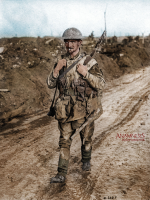- Reaction score
- 23,538
- Points
- 1,260
Well obviously the status quo is bad, and treating a new trade managed by its own branch, with its own school and courses will solve our problems.
Actually I do think the status quo isn’t working. I see proof of that based on the current make up of the CA.
Further derailing the Infanty vehicle thread - but here goes, and I will see if I can tie it back to vehicles by the end.
There are several skills that are more specific to Light Forces and need constant work if one if going to do it to a high standard safely.
Climbing/Mountaineering
Airborne Operations
Amphibious/Maritime/Water Operations.
High Arctic Operations
In the same vein, as there are only so many training hours in a day, week, month, year. You cannot expect Armored Fighting Vehicle crews to be at the top of their game if they are not out training for that task. GIB's however need to be able to conduct dismounted infantry work, and provide backup crews for the AFV's - needless to say you aren't going to be able to get everything under the sun done that needs to be done.
One method of doing that is having the Infantry solely be Infantry - Light, and then let other drive and crew the vehicles -- but that doesn't really work for the integration of fighting the vehicle with the dismounted section/squad.
I think there are 4 main classes of Infantry Vehicles
1) Transport Integral
2) Transport External
3) Protected Mobility
4) Fighting Vehicle
For theTransport Integral, these are generally soft skin vehicles that are used for admin mobility, and don't require a dedicated crew. So vehicles like the ISV, GMV, Hummer, SnowMobiles, ATV's etc. They are not designed to be involved in the fight, but simply logistics and admin support functions - that the Section/Squad can use as required, but are not wedded to the vehicle.
Transport External was just my catchall for stuff like Aircraft, Helicopters, Ships/Boats, Wheeled Logistics Transports used for TCV etc. They aren't a Sub Unit holding and likely not a unit holding - but used for mobility as required, and the sub units are not wedded to the vehicle at all.
Protected Mobility, this is the column where I wonder if a Armoured/Armored Transport Corps is worthwhile - it is an armored vehicle with a crew, so the crew cannot detach (easily) from the vehicle. They are primarily used for movement under a threat - but not really as a direct fighting vehicle -- the Stryker, Bison, M113, AMPV, TAPV, MRAP's, and even the Armored Hummers are all examples of this (some good, some bad, and some down right awful). Since the crew isn't expected to fight the vehicle with the dismounts, there isn't the direct need to have the crew/GIBs be an organic unit.
Fighting Vehicle, this is the area where I have a tough time with the LAV. As generally the goal of the IFV was to fight the vehicle along with tanks up onto the objective - and then dismount the GIB's. The Germans with the Marder II were really the pioneers in the West - followed up by Bradley and Warrior. It isn't quite a tank as far as armor goes (albeit the latest Bradley M2A4 is getting pretty close) and the Israeli Namer is a tank without a gun turret, but they are intended to fight up with tanks, sometimes slightly trailing other times abreast and intermixed with the MBT's.
Now down here we eliminated the 11M Mechanized Infantry MOS, with the concept that it would streamline the Infantry trade - and with the adoption of the Stryker there was no appetite to make a third specific MOS for that, as well as the removal of the 11H Anti-Armor Infantryman. The only separate Infantry MOS down here is 11C Mortarman (technical Indirect Fire Infantryman). The 11H was dropped as the 11M had most of it already due to the TOW in the Bradley, and the 11B's using the TOW in the M1121 Hummer, and the M901 TUA had been withdrawn in the 1994/5 time frame due to being redundant with the Bradleys.
It briefed well - however now you have 11B MOS spanning folks from Ranger Batts, to Bradley units in CAB's, all theoretically interchangeable (a Ranger E-7 can go from Batt to a CAB to be a Platoon Sgt, which is quite a culture shock, and has a massive difference in required knowledge). The 11C was retained as it was viewed as agnostic, but very few folks in Armored Div's want to go to the 82nd to walk around with 81's on their back. I personally think the 11B and 11M are separate enough that they should be reinstated - but drop the 11C and folks them into either the B or M trades.
Thank you for ignoring my Ted talk.




